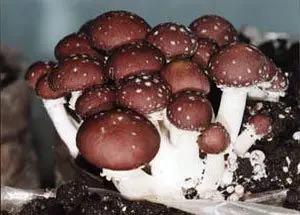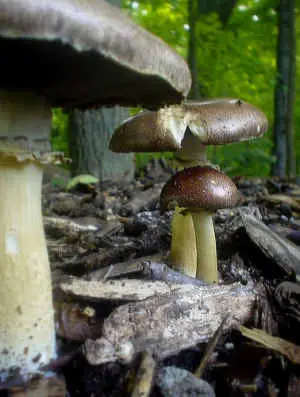Stropharia ring (Stropharia rugoso-annulata)
- Division: Basidiomycota (Basidiomycetes)
- Subdivision: Agaricomycotina (Agaricomycetes)
- Class: Agaricomycetes (Agaricomycetes)
- Subclass: Agaricomycetidae (Agaricomycetes)
- Order: Agaricales (Agaric or Lamellar)
- Family: Strophariaceae (Strophariaceae)
- Genus: Stropharia (Stropharia)
- Type: Stropharia rugoso-annulata
- Stropharia ferry
- Koltsevik
- Stropharia ferrii

Hat:
at a young age, the surface of the cap of this fairly common and today cultivated fungus changes color from yellowish to red-brown. In mature mushrooms, the cap takes on a color from pale yellow to chestnut. In diameter, the hat can reach up to 20 cm. The mushroom weighs about one kilogram. In young mushrooms, the cap has a hemispherical shape, resembling porcini mushrooms. But, the curved edge of their cap is connected to the leg with a thin skin, which bursts when the cap ripens and the fungus grows. In young ringworms, the lamers are gray. With age, they become darker, purple, just like the spores of the fungus.
Leg:
the surface of the stem may be white or tan. There is a ring on the leg. The flesh in the leg is very dense. The length of the leg can reach 15 cm.
Pulp:
under the skin of the cap, the flesh is slightly yellowish. It has a rare smell and a mild, pleasant taste.
Edibility:
Ringworm is an edible valuable mushroom, it tastes like a white mushroom, although it has a specific smell. The pulp of the mushroom contains many B vitamins and many minerals. It contains more nicotinic acid than cucumbers, cabbage and tomatoes. This acid has a beneficial effect on the digestive organs and nervous system.
 Similarity:
Similarity:
Ringlets are the same lamellar as russula, but in color and shape they are more reminiscent of noble mushrooms. The taste of Koltsevik resembles a boletus.
Spread:
For mushrooms of this species, it is enough to simply prepare a nutrient substrate. Compared to champignons, they are not whimsical to growing conditions in home gardens. Ringworm mainly grows on well-fertilized soil, on the remains of plants outside the forest, less often in deciduous forests. The fruiting period is from early summer to mid-autumn. For backyard cultivation, they choose warm places protected from the wind. It can also be grown under film, in greenhouses, basements and beds.









